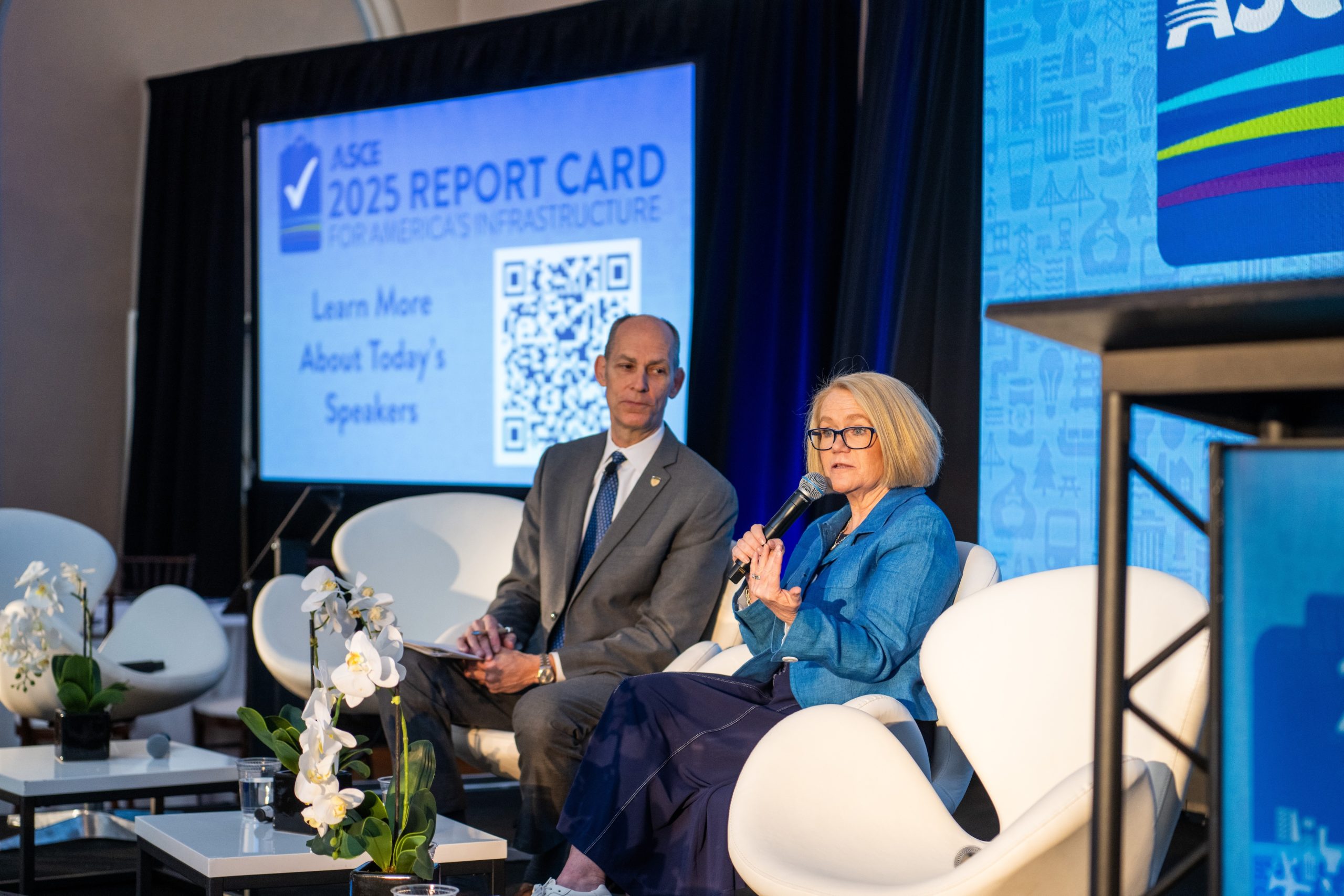
Amy Bunszel participates in a fireside chat at the American Society of Civil Engineers’ Solutions Summit.
Last week, in Washington D.C., Autodesk sponsored the American Society of Civil Engineers’ (ASCE) Solutions Summit, which was timed with the release of its 2025 Infrastructure Report. The report card awarded the United States a C—the highest grade in the report’s history. Published every four years, the Report Card offers a comprehensive assessment of the nation’s infrastructure systems. And while a C may signal progress, ASCE’s message is clear: we still have a long road ahead.
While attending the summit, I participated in a fireside chat with ASCE Director, Tom Smith, attended by key infrastructure leaders, engineers, and policymakers. I also had the unique opportunity to meet one-on-one with policymakers as well as host a salon dinner with media representatives and industry leaders, all to further the discussion of how digital solutions should be prioritized to get America’s infrastructure back on track.
ASCE’s report is key to informing the next infrastructure bill, and highlights areas in need of improvement that align with Autodesk’s recently released Policy Recommendations to the Trump-Vance Administration and 119th Congress.
The US faces a $3.7 trillion infrastructure investment gap, and according to ASCE, American households lose roughly $2,000 annually due to poor infrastructure. The opportunity is here—not just to fix what’s broken, but to build smarter, more resilient infrastructure for the future. Here’s what you need to know–and how Autodesk is helping move the US in the right direction.
1. America’s infrastructure is improving—but still underperforming
The C grade may be a step up from the previous C-, but it’s not a grade anyone would brag about. Eleven of the 18 assessed categories still fall in the D range (see full list of grades). While investments from the Infrastructure Investment and Jobs Act are starting to show results, decades of underfunding have left deep deficits. ASCE’s takeaway: improvement is real, but uneven—and far from complete.
2. Sustained investment is essential
Increased federal funding has helped raise the grade, but maintaining this momentum is crucial. ASCE’s report emphasizes that sustained funding is the only way to close the $3.7 trillion investment gap and avoid long-term economic consequences. ASCE notes that continued investment through 2033 could help save the US economy as much as $637 billion in GDP.
3. Smart infrastructure starts with smart technology
Traditional tools and outdated workflows can’t keep up with 21st-century infrastructure needs. Autodesk is helping engineers and agencies make the leap with advanced tools like Building Information Modeling (BIM), digital twins, and AI-driven solutions. These technologies allow for faster planning, more accurate designs, and infrastructure that’s easier to maintain and more resilient to stress. The result: less waste, smarter spending, better outcomes.
For example, using Autodesk software, Dallas Fort Worth International Airport (DFW) has embraced data-driven decision-making to improve infrastructure planning, maintenance, and operational efficiency. By leveraging real-time data insights and predictive maintenance technologies, DFW has been able to reduce time spent on reporting by 40 hours per week, improve asset management and maintenance planning, and enhance collaboration among stakeholders.
What’s more, the Indiana Department of Transportation (INDOT) delivered a $2 billion highway expansion using Autodesk Construction Cloud (ACC), which reduced drive times for local communities. ACC enabled INDOT designers, engineers, and contractors to manage project documentation in one central environment, which increased transparency, removed bottlenecks, and enabled the project to be delivered on schedule and within budget.
4. Resilience is the new baseline
ASCE’s report emphasizes that resilient infrastructure saves money and lives. Every $1 spent on resilience can save $13 in post-disaster recovery costs. Autodesk empowers design teams to simulate future conditions and stress-test projects long before construction starts. This kind of planning isn’t optional anymore—it’s essential.
A strong example of this approach comes from the City of San Marcos, Texas—located in the heart of “Flash Flood Alley.” Working with the consulting firm Lockwood, Andrews, and Newman, the city leveraged Autodesk technology to build a digital twin hydraulic model of its stormwater system. The model allowed engineers to simulate flash flood scenarios, analyze vulnerabilities in real time, and proactively strengthen the city’s defenses. This project shows how digital tools can turn reactive responses into strategic, life-saving planning.
5. Competitiveness depends on collaboration and workforce readiness
Infrastructure investment isn’t just about steel and concrete—it’s about people. Closing the infrastructure gap requires coordination between government, industry, and tech leaders. Autodesk is investing in workforce development through training, education partnerships, and accessible tools. It’s a strategy that not only addresses current challenges but builds the capacity to meet future demands.
This is the moment
The 2025 ASCE Infrastructure Report Card isn’t just a status update—it’s a wake-up call. The highest grade on record should be a rallying point, not a resting place. Sustained investment, smarter design, and strong public-private partnerships can transform American infrastructure from a liability into a strategic advantage. With companies like Autodesk leading the charge, innovation isn’t just a buzzword, it’s a blueprint. The tools to boost America’s infrastructure GPA aren’t just coming, they’re already at work.